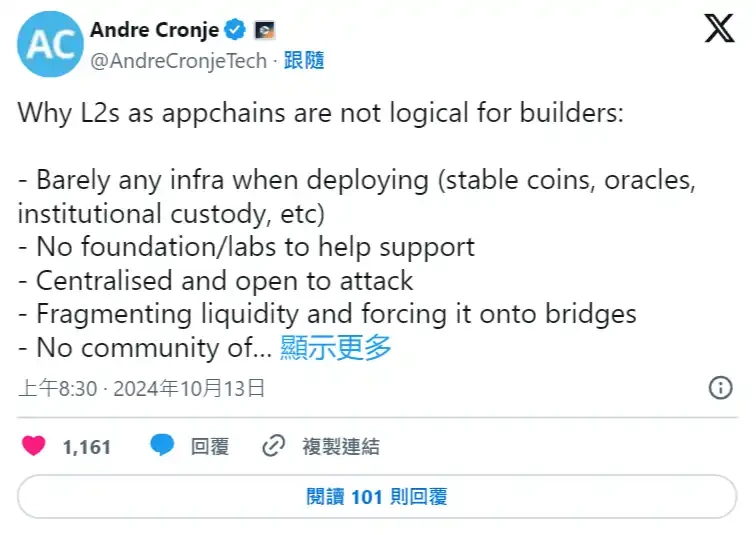Andre Cronje: Layer 2 ist nutzlos und nur Geldverschwendung, da doppelte Arbeit anfällt
Original author: James, BlockTempo
Since pioneers such as Arbitrum and Optimism began building Layer 2 networks on Ethereum a few years ago to support faster and cheaper transaction experiences, Layer 2 networks have sprung up like mushrooms. According to L2 Beat data, there are currently 73 operating Layer 2s, 20 Layer 3s, 81 upcoming projects and 12 archived projects.
However, Andre Cronje, the director of Fantom Foundation and the chief technology officer of Sonic Labs, who are known as the father of DeFi, tweeted today, pointing their guns at L2, saying that L2 as an application chain is illogical for developers, and listed several reasons:
-
Deployed with almost no infrastructure (stablecoins, oracles, institutional custody, etc.)
-
No foundation or lab to help
-
Centralized architecture is vulnerable to attacks
-
Decentralize liquidity and force it to pass through cross-chain bridges
-
No user and developer community
-
Spend time dealing with the above issues instead of focusing on applications and users
-
Eliminating the network effect
-
Transaction confirmation time is still long (some suppliers are unwilling to cooperate)
-
Solo development (no collaborative team)
Andre Cronje also said that the application chain has seriously underestimated the cost of infrastructure and compliance (including browsers, hosts, trading platforms, oracles, bridges, toolkits, integrated development environments, deposits and withdrawals, native issuance and integration, supervision, and compliance). In 2024 alone, the application chain has spent US$14 million, a large part of which is recurring costs.
Developers were discussing Andre Cronjes statement. Some developers expressed their agreement, saying, I 100% agree that it is meaningless to build products on the application chain without the support and help of the foundation and Considering such a large expense, I am curious why there are more L2s to be launched and a large number of transactions are required to make money.
But some developers disagree. One developer said that although the available infrastructure of the one-size-fits-all L2 is limited, the stronger composability between L2 (and even L1) completely eliminates the need for local stablecoins, oracles, and institutional custody, and few people understand the framework shift.
The developer also disagreed with many of Andre Cronjes arguments, emphasizing that the L2 application chain is of course decentralized and secure. He admitted that the infrastructure cost of the application chain may be higher than that of a pure application, but he firmly believed that as competition for service demand intensified, the cost of many infrastructures would approach zero.
Andre Cronje pushes Sonic
In Andre Cronjes opinion, Layer 1 should focus on using technology to enhance its scalability rather than constantly creating problems for Layer 2. He is currently leading the design and development of the Layer 1 blockchain Sonic (formerly Fantom) network. The Fantom Foundation first announced in October last year that it would launch Sonic to improve scalability and performance.
In early September this year, the Sonic testnet was officially launched. Andre Cronje then announced on September 25 that the Sonic mainnet will be officially launched in December this year, inviting developers to build applications on its ecosystem. He also stated that Sonic introduced a credit scoring mechanism and has the opportunity to become the first public chain to unlock a $11.3 trillion market (the size of the global unsecured loan market).
At the time, Andre Cronje had been promoting the performance of his own Sonic network, including that up to 90% of transaction fees would be returned to developers, the number of transactions per second (TPS) exceeded 10,000, transaction finality (TTF) was about 1 second, and native stablecoins were supported. In terms of bridging with Ethereum, the company was committed to developing Sonic Gateways new native bridging technology to greatly improve the security and convenience of transferring assets from other chains.
This article is sourced from the internet: Andre Cronje: Layer 2 is useless and is just a waste of money doing duplicate work
Verwandt: Cube Exchange: Erkundung der nächsten Billionen-Dollar-Marktchance im Solana-Ökosystem
Der Zusammenbruch von FTX hat nicht nur das Vertrauen unzähliger Anleger zerstört, sondern auch das Fundament des gesamten Kryptomarktes erschüttert. Viele Anleger haben aufgrund dieses Vorfalls kein Vertrauen mehr in Kryptowährungen und begannen, die Zuverlässigkeit der gesamten Branche in Frage zu stellen. Die einst glamouröse zentralisierte Handelsplattform gehörte augenblicklich der Vergangenheit an. Dieser Vertrauensverlust hat drastische Marktschwankungen ausgelöst und der Preis von Kryptowährungen ist in kurzer Zeit eingebrochen. Die Liquidität des Marktes ist fast versiegt und die Gelder der Benutzer wurden in großem Umfang geschädigt. Ein solch katastrophales Ereignis verdeutlicht die enormen Risiken einer übermäßigen Abhängigkeit von zentralisierten Handelsplattformen und weckt bei den Benutzern des Kryptomarktes auch Zweifel an der Sicherheit,…








